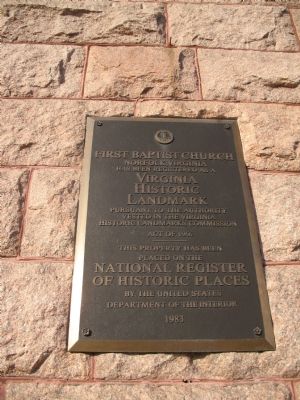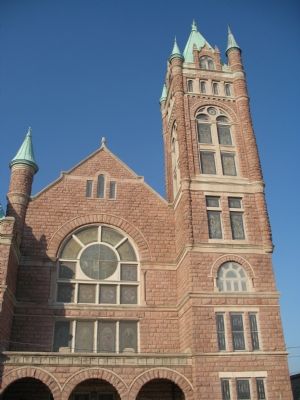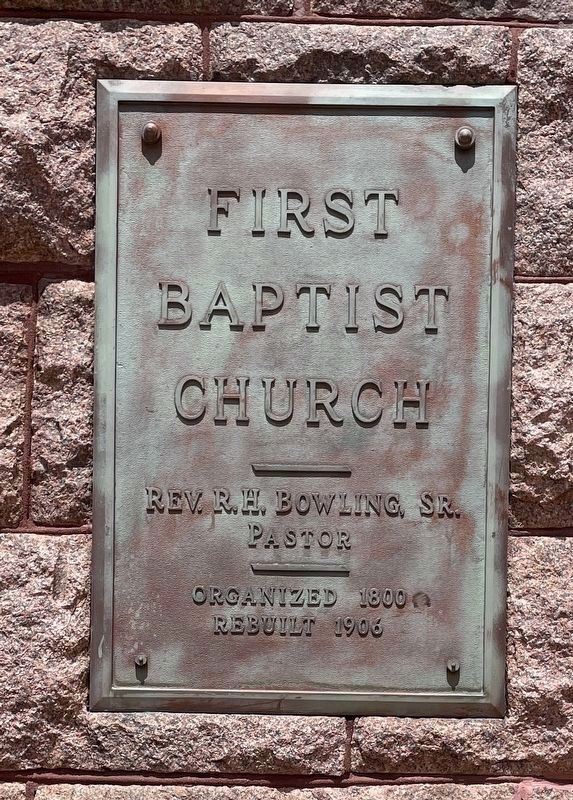Downtown in Norfolk, Virginia — The American South (Mid-Atlantic)
First Baptist Church
First Baptist Church Norfolk Virginia has been registered as a Virginia Historic Landmark pursuant to the authority vested in the Virginia Historic Landmarks Commission act of 1966
This property has been placed on the National Register of Historic Places by the United States Department of the Interior
1983
Erected 1983 by Virginia Historic Landmarks Commission.
Topics. This historical marker is listed in these topic lists: African Americans • Churches & Religion • Civil Rights.
Location. 36° 51.154′ N, 76° 17.057′ W. Marker is in Norfolk, Virginia. It is in Downtown. Marker is at the intersection of East Bute Street and Posey Lane, on the right when traveling west on East Bute Street. Touch for map. Marker is at or near this postal address: 418 E Bute Street, Norfolk VA 23510, United States of America. Touch for directions.
Other nearby markers. At least 8 other markers are within walking distance of this marker. First Baptist Church, Bute Street (a few steps from this marker); AKA Iota Omega (a few steps from this marker); Bank Street Baptist Church (about 600 feet away, measured in a direct line); St. John’s African Methodist Episcopal Church (about 600 feet away); Francis Drake, Free Black Barber (approx. 0.2 miles away); Evelyn Thomas Butts (approx. 0.2 miles away); St. Joseph’s Catholic Church & School (approx. 0.2 miles away); Freemason Street Baptist Church (approx. 0.2 miles away). Touch for a list and map of all markers in Norfolk.
Also see . . . First Baptist Church. (Submitted on August 9, 2022.)
Additional commentary.
1. 1983 National Register of Historic Places Nomination Form
Excerpt from the nomination form prepared by the Virginia Historic Landmarks Commission staff.
Statement of Significance.
Norfolk’s First Baptist Church houses a worshipping community that arose out of the city’s first Baptist congregations to nurture a strong sense of leadership and identity for the black community in the antebellum period. Built in 1906 on the site of the original church of 1830, the monumental Romanesque Revival structure is among the best representatives of its style in the state and was designed by t:.’1e noted early 20th-century Tennessee architect Reuben H. Hunt, whose practice centered on Southern ecclesiastical buildings, most notably in Birmingham, Chattanooga, and Dallas. His work included Court Street Baptist Church in nearby Portsmouth. The building, with its unusually large scale and imposing quality, reflects the growing economic strength of Norfolk’s black community by the end of the 19th century as well as the important position of black religious institutions in the urban life of the South in more recent times.
Historical Background.
The history of the congregation of First Baptist Church, Bute Street in Norfolk,
dates to its organization in 1800 by David Biggs and Thomas Everidge of the Court Street Baptist Church in Portsmouth. Made up of whites, free Negroes, and slaves, the Norfolk congregation by 1805 had grown considerably and had adapted the Borough Church—abandoned by Norfolk Anglicans with the disestablishment—as its worship place. With the black population of Norfolk estimated at 45 percent at the beginning of the 19th century, a substantial portion of the early membership of the church was black. By 1816, however, several white members of the congregation became dissatisfied with the large numbers of blacks in their midst and left to found the Cumberland Baptist Church. The original congregation continued to occupy the Borough Church building. Although the congregation remained an integrated community and was led by a white pastor, the First Baptist Church became known as a “colored” congregation. In 1830 three free black trustees paid $250 for the present Bute Street site and erected a sanctuary there later known as the “Old salt Box.” In 1839 sane Negro members left to fonn another congregation known as the Bank Street Church. From this time on for the remainder of the 19th century, the sanctuary of the First Baptist Church was known as the Bute Street Church.
During the entire antebellum period, all black congregations were required to have white pastors. Free blacks filled the posts of deacons, trustees, and clerks of the congregation, however, and the congregation had the right to call and dismiss pastors as well as the responsibility for paying their salaries. This situation provided an important arena for training free blacks for leadership positions. Leaders of the Bute Street congregation provided basic education to its members in addition to theological and moral instruction. The black church provided a place for both slaves and free blacks to meet, socialize, and exchange ideas. Black churches such as First Baptist thus acted as a training ground for the freedom that was to come with emancipation. According to one authority on the subject, “... the church became the most important institution in the black community and it epitomized the adaptive genius of the transplanted African in modifying aspects of the slave masters’ culture to his own purposes.”
Following Federal occupation of Norfolk in 1862, the Reverend Lewis Tucker became First Baptist Church’s first black pastor, and he continued in that capacity until 1870. For the next three decades the largest concentration of blacks in the city occupied the old downtown area of Norfolk and was served by First Baptist Church, Bute Street.
By the end of the 19th century, blacks in Norfolk had obtained a level of prosperity and property ownership that was nearly unrivaled in the state. According to an article in Science in 1906, the increased wealth of blacks as property owners in Virginia towns and cities increased from 4.65 million in 1891 to 6.35 million in 1903, a percentage in excess of white property holdings during the same period and a rate higher than the percentage increase in the black population. The Negro church was recognized as the “only sound institution of Negroes which started in the African forest and survived slavery.” A Nation article of 1904, in discussing an 1898 Atlanta conference, said that the black Church in America had preserved remnants of African tribal life and remained the center of contemporary Negro social life. The article noted that in large Southern cities, black church leaders were highly respected by whites in their communities.
It was in this positive economic and social atmosphere that the present First Baptist edifice was erected in 1906 under the leadership of their respected pastor, Richard H. Bowling, Sr. Norfolk’s economy was thriving at the time, reflective of the city’s growth as a transportation and shipping center. The building was designed by the successful Tennessee architect Reuben H. Hunt, who was responsible for Portsmouth’s Court Street Baptist Church (1903). According to older members of the congregation, much of the actual construction of the present building was done by members of the church; bake sales were held to raise funds to purchase bricks and to offset the construction cost of $52,000. From contemporary church records, it is apparent that the “Old Salt Box” was replaced in 1877 by a brick structure which served the congregation until 1904.
Upon completion in 1906, the building received much praise in the press. The (Norfolk) Virginian-Pilot called the building the “handsomest church owned by the race in the south.” The (Richmond) Planet, reporting on the 30th Annual Session of the Virginia Baptist State Convention held in the new sanctuary, called it “a magnificent church edifice.” The mayor of the city of Norfolk gave a formal address of welcome to the delegates at the dedication calling the church “a monument to the race which would be handed down from a race that loved God.”
First Baptist Church has continued to serve the urban black community of Norfolk throughout the 20th century. In 1960 an education building was added to the church complex, designed by black Norfolk architect Harvey N. Johnson, who was also responsible in his younger days for the Attucks Theatre, Norfolk (National Register of Historic Places, 1982), built in 1920. The church sanctuary is a tribute to the important position held by the church in black history as well as an important landmark to the remarkable history of the black community in Norfolk.
— Submitted February 1, 2023.
Credits. This page was last revised on October 26, 2023. It was originally submitted on November 5, 2007, by Laura Troy of Burke, Virginia. This page has been viewed 1,179 times since then and 39 times this year. Last updated on August 8, 2022, by Brandon D Cross of Flagler Beach, Florida. Photos: 1, 2, 3. submitted on November 5, 2007, by Laura Troy of Burke, Virginia. 4. submitted on August 8, 2022, by Brandon D Cross of Flagler Beach, Florida. • Bernard Fisher was the editor who published this page.



